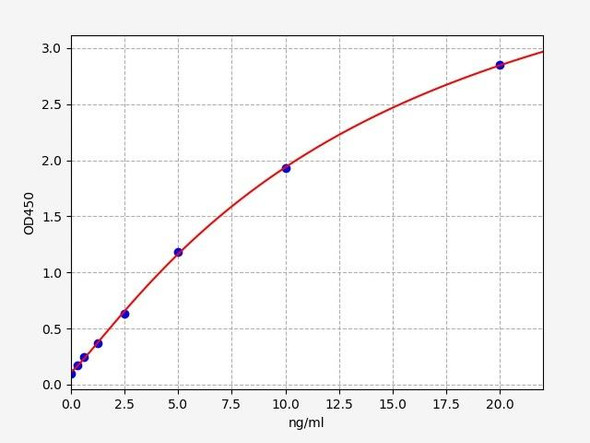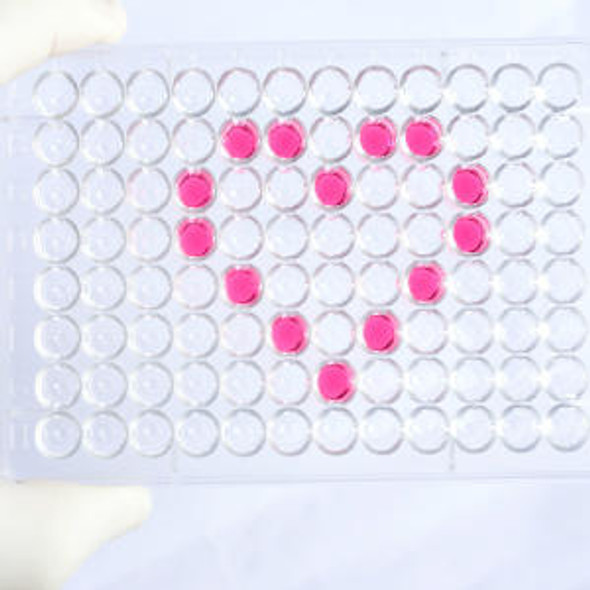Human PRKACA ELISA Kit
- SKU:
- HUFI01678
- Product Type:
- ELISA Kit
- Size:
- 96 Assays
- Uniprot:
- P17612
- Sensitivity:
- 0.469ng/ml
- Range:
- 0.781-50ng/ml
- ELISA Type:
- Sandwich
- Synonyms:
- PRKACA, cAMP-dependent protein kinase catalytic subunit alpha, PKA C-alpha
- Reactivity:
- Human
- Research Area:
- Cell Biology
Description
Human PRKACA ELISA Kit
The Human PRKACA (Protein Kinase cAMP-Activated Catalytic Subunit Alpha) ELISA Kit is specifically designed for the accurate quantification of PRKACA levels in human samples including serum, plasma, and cell culture supernatants. This kit offers high sensitivity and specificity, ensuring precise and reproducible results for a variety of research applications.PRKACA is a key enzyme involved in cell signaling pathways, playing a crucial role in processes such as cell growth, differentiation, and metabolism.
Dysregulation of PRKACA activity has been linked to various diseases including cancer, metabolic disorders, and neurodegenerative conditions, highlighting its importance as a potential biomarker for disease research and therapeutic development.Overall, the Human PRKACA ELISA Kit provides researchers with a reliable tool for studying the role of PRKACA in health and disease, offering valuable insights into its function and potential implications for future treatments.
| Product Name: | Human PRKACA ELISA Kit |
| Product Code: | HUFI01678 |
| Size: | 96 Assays |
| Alias: | PRKACA, cAMP-dependent protein kinase catalytic subunit alpha, PKA C-alpha |
| Detection method: | Sandwich ELISA, Double Antibody |
| Application: | This immunoassay kit allows for the in vitro quantitative determination of Human PRKACA concentrations in serum plasma and other biological fluids. |
| Sensitivity: | 0.469ng/ml |
| Range: | 0.781-50ng/ml |
| Storage: | 4°C for 6 months |
| Note: | For Research Use Only |
| Recovery: | Matrices listed below were spiked with certain level of Human PRKACA and the recovery rates were calculated by comparing the measured value to the expected amount of Human PRKACA in samples. | ||||||||||||||||
| |||||||||||||||||
| Linearity: | The linearity of the kit was assayed by testing samples spiked with appropriate concentration of Human PRKACA and their serial dilutions. The results were demonstrated by the percentage of calculated concentration to the expected. | ||||||||||||||||
| |||||||||||||||||
| CV(%): | Intra-Assay: CV<8% Inter-Assay: CV<10% |
| Component | Quantity | Storage |
| ELISA Microplate (Dismountable) | 8×12 strips | 4°C for 6 months |
| Lyophilized Standard | 2 | 4°C/-20°C |
| Sample/Standard Dilution Buffer | 20ml | 4°C |
| Biotin-labeled Antibody(Concentrated) | 120ul | 4°C (Protect from light) |
| Antibody Dilution Buffer | 10ml | 4°C |
| HRP-Streptavidin Conjugate(SABC) | 120ul | 4°C (Protect from light) |
| SABC Dilution Buffer | 10ml | 4°C |
| TMB Substrate | 10ml | 4°C (Protect from light) |
| Stop Solution | 10ml | 4°C |
| Wash Buffer(25X) | 30ml | 4°C |
| Plate Sealer | 5 | - |
Other materials and equipment required:
- Microplate reader with 450 nm wavelength filter
- Multichannel Pipette, Pipette, microcentrifuge tubes and disposable pipette tips
- Incubator
- Deionized or distilled water
- Absorbent paper
- Buffer resevoir
| Uniprot | P17612 |
| UniProt Protein Function: | PKACA: catalytic subunit of cAMP-dependent protein kinase alpha, an AGC kinase. A number of inactive tetrameric holoenzymes are produced by the combination of homo- or heterodimers of the different regulatory subunits associated with two catalytic subunits. cAMP causes the dissociation of the inactive holoenzyme into a dimer of regulatory subunits bound to four cAMP and two free monomeric catalytic subunits. Two splice-variant isoforms have been described. |
| UniProt Protein Details: | Protein type:Protein kinase, AGC; Protein kinase, Ser/Thr (non-receptor); Kinase, protein; EC 2.7.11.11; AGC group; PKA family Chromosomal Location of Human Ortholog: 19p13.1 Cellular Component: centrosome; membrane; mitochondrion; plasma membrane; cytosol; nucleus; neuromuscular junction; AMP-activated protein kinase complex; cAMP-dependent protein kinase complex Molecular Function:protein binding; cAMP-dependent protein kinase activity; ubiquitin protein ligase binding; protein serine/threonine/tyrosine kinase activity; protein kinase binding; ATP binding Biological Process: nerve growth factor receptor signaling pathway; protein amino acid autophosphorylation; water transport; pathogenesis; signal transduction; protein amino acid phosphorylation; positive regulation of protein export from nucleus; triacylglycerol catabolic process; G2/M transition of mitotic cell cycle; transmembrane transport; sperm capacitation; regulation of synaptic transmission; epidermal growth factor receptor signaling pathway; fibroblast growth factor receptor signaling pathway; cytosolic calcium ion homeostasis; regulation of osteoblast differentiation; regulation of heart rate; organelle organization and biogenesis; activation of protein kinase A; peptidyl-threonine phosphorylation; glucose metabolic process; gluconeogenesis; peptidyl-serine phosphorylation; mesoderm formation; phospholipase C activation; regulation of protein binding; neural tube closure; carbohydrate metabolic process; energy reserve metabolic process; innate immune response; renal water homeostasis; mitotic cell cycle; blood coagulation; regulation of insulin secretion |
| NCBI Summary: | cAMP is a signaling molecule important for a variety of cellular functions. cAMP exerts its effects by activating the cAMP-dependent protein kinase, which transduces the signal through phosphorylation of different target proteins. The inactive kinase holoenzyme is a tetramer composed of two regulatory and two catalytic subunits. cAMP causes the dissociation of the inactive holoenzyme into a dimer of regulatory subunits bound to four cAMP and two free monomeric catalytic subunits. Four different regulatory subunits and three catalytic subunits have been identified in humans. The protein encoded by this gene is a member of the Ser/Thr protein kinase family and is a catalytic subunit of cAMP-dependent protein kinase. Alternatively spliced transcript variants encoding distinct isoforms have been observed. [provided by RefSeq, Jul 2008] |
| UniProt Code: | P17612 |
| NCBI GenInfo Identifier: | 125205 |
| NCBI Gene ID: | 5566 |
| NCBI Accession: | P17612.2 |
| UniProt Secondary Accession: | P17612,Q32P54, Q9H2Y0, Q9NRB4, Q9NRH9, |
| UniProt Related Accession: | P17612 |
| Molecular Weight: | 39,953 Da |
| NCBI Full Name: | cAMP-dependent protein kinase catalytic subunit alpha |
| NCBI Synonym Full Names: | protein kinase, cAMP-dependent, catalytic, alpha |
| NCBI Official Symbol: | PRKACA |
| NCBI Official Synonym Symbols: | PKACA |
| NCBI Protein Information: | cAMP-dependent protein kinase catalytic subunit alpha; PKA C-alpha; protein kinase A catalytic subunit; cAMP-dependent protein kinase catalytic subunit alpha, isoform 1 |
| UniProt Protein Name: | cAMP-dependent protein kinase catalytic subunit alpha |
| Protein Family: | cAMP-dependent protein kinase |
| UniProt Gene Name: | PRKACA |
| UniProt Entry Name: | KAPCA_HUMAN |
*Note: Protocols are specific to each batch/lot. For the correct instructions please follow the protocol included in your kit.
Before adding to wells, equilibrate the SABC working solution and TMB substrate for at least 30 min at 37°C. When diluting samples and reagents, they must be mixed completely and evenly. It is recommended to plot a standard curve for each test.
| Step | Protocol |
| 1. | Set standard, test sample and control (zero) wells on the pre-coated plate respectively, and then, record their positions. It is recommended to measure each standard and sample in duplicate. Wash plate 2 times before adding standard, sample and control (zero) wells! |
| 2. | Aliquot 0.1ml standard solutions into the standard wells. |
| 3. | Add 0.1 ml of Sample / Standard dilution buffer into the control (zero) well. |
| 4. | Add 0.1 ml of properly diluted sample ( Human serum, plasma, tissue homogenates and other biological fluids.) into test sample wells. |
| 5. | Seal the plate with a cover and incubate at 37 °C for 90 min. |
| 6. | Remove the cover and discard the plate content, clap the plate on the absorbent filter papers or other absorbent material. Do NOT let the wells completely dry at any time. Wash plate X2. |
| 7. | Add 0.1 ml of Biotin- detection antibody working solution into the above wells (standard, test sample & zero wells). Add the solution at the bottom of each well without touching the side wall. |
| 8. | Seal the plate with a cover and incubate at 37°C for 60 min. |
| 9. | Remove the cover, and wash plate 3 times with Wash buffer. Let wash buffer rest in wells for 1 min between each wash. |
| 10. | Add 0.1 ml of SABC working solution into each well, cover the plate and incubate at 37°C for 30 min. |
| 11. | Remove the cover and wash plate 5 times with Wash buffer, and each time let the wash buffer stay in the wells for 1-2 min. |
| 12. | Add 90 µl of TMB substrate into each well, cover the plate and incubate at 37°C in dark within 10-20 min. (Note: This incubation time is for reference use only, the optimal time should be determined by end user.) And the shades of blue can be seen in the first 3-4 wells (with most concentrated standard solutions), the other wells show no obvious color. |
| 13. | Add 50 µl of Stop solution into each well and mix thoroughly. The color changes into yellow immediately. |
| 14. | Read the O.D. absorbance at 450 nm in a microplate reader immediately after adding the stop solution. |
When carrying out an ELISA assay it is important to prepare your samples in order to achieve the best possible results. Below we have a list of procedures for the preparation of samples for different sample types.
| Sample Type | Protocol |
| Serum | If using serum separator tubes, allow samples to clot for 30 minutes at room temperature. Centrifuge for 10 minutes at 1,000x g. Collect the serum fraction and assay promptly or aliquot and store the samples at -80°C. Avoid multiple freeze-thaw cycles. If serum separator tubes are not being used, allow samples to clot overnight at 2-8°C. Centrifuge for 10 minutes at 1,000x g. Remove serum and assay promptly or aliquot and store the samples at -80°C. Avoid multiple freeze-thaw cycles. |
| Plasma | Collect plasma using EDTA or heparin as an anticoagulant. Centrifuge samples at 4°C for 15 mins at 1000 × g within 30 mins of collection. Collect the plasma fraction and assay promptly or aliquot and store the samples at -80°C. Avoid multiple freeze-thaw cycles. Note: Over haemolysed samples are not suitable for use with this kit. |
| Urine & Cerebrospinal Fluid | Collect the urine (mid-stream) in a sterile container, centrifuge for 20 mins at 2000-3000 rpm. Remove supernatant and assay immediately. If any precipitation is detected, repeat the centrifugation step. A similar protocol can be used for cerebrospinal fluid. |
| Cell culture supernatant | Collect the cell culture media by pipette, followed by centrifugation at 4°C for 20 mins at 1500 rpm. Collect the clear supernatant and assay immediately. |
| Cell lysates | Solubilize cells in lysis buffer and allow to sit on ice for 30 minutes. Centrifuge tubes at 14,000 x g for 5 minutes to remove insoluble material. Aliquot the supernatant into a new tube and discard the remaining whole cell extract. Quantify total protein concentration using a total protein assay. Assay immediately or aliquot and store at ≤ -20 °C. |
| Tissue homogenates | The preparation of tissue homogenates will vary depending upon tissue type. Rinse tissue with 1X PBS to remove excess blood & homogenize in 20ml of 1X PBS (including protease inhibitors) and store overnight at ≤ -20°C. Two freeze-thaw cycles are required to break the cell membranes. To further disrupt the cell membranes you can sonicate the samples. Centrifuge homogenates for 5 mins at 5000xg. Remove the supernatant and assay immediately or aliquot and store at -20°C or -80°C. |
| Tissue lysates | Rinse tissue with PBS, cut into 1-2 mm pieces, and homogenize with a tissue homogenizer in PBS. Add an equal volume of RIPA buffer containing protease inhibitors and lyse tissues at room temperature for 30 minutes with gentle agitation. Centrifuge to remove debris. Quantify total protein concentration using a total protein assay. Assay immediately or aliquot and store at ≤ -20 °C. |
| Breast Milk | Collect milk samples and centrifuge at 10,000 x g for 60 min at 4°C. Aliquot the supernatant and assay. For long term use, store samples at -80°C. Minimize freeze/thaw cycles. |









